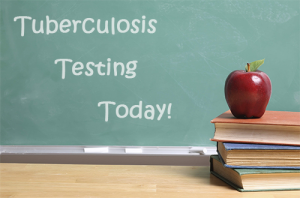
Tuberculosis (TB), a highly-contagious disease that attacks the lungs, affects millions of people all around the world. While there is no vaccine, early detection is the best way to control its spread and avoid new cases. Early detection is generally done through a tuberculosis skin test (TST), also known as a PPD implant. A TB test such as a PPD is required for all New York City teachers and for many valid reasons.
First, it is important to understand what tuberculosis is and how it effects the human body. Tuberculosis is caused by a bacteria known as Mycobacterium bovis which at one time affected cattle primarily. This disease then started affecting humans as the airborne bacteria can be inhaled and cause fatal damage to the lungs.
When a person inhales TB germs into their lungs, a defensive wall is created by his/her body around the germs in order to isolate them. While this will protect the body initially, the person now has what is called latent TB infection (LTBI). These latent germs will not hurt the body immediately but if the body’s natural defenses start to diminish, the latent TB germs can become active.
TB is one of the most common virulent epidemics in the world. The disease is mainly prevalent in developing countries, where unpasteurized & contaminated milk products from infected cattle are ingested by consumers. In addition, TB has a large presence in the Caribbean, Eastern Europe, Latin America, Asia, & Africa.
But, you might be thinking, what does this have to do with being a NYC Teacher? As you are probably aware, New York City is one of the most culturally diverse cities in the entire world; complete with foreign residents, frequent travelers and tourists from around the world. All of these factors increase the risk that these new residents and visitors have either come from (or visited) a region of the world that has a very active TB presence.
More than any other industry, the New York City school system has the most interpersonal exposure due to the massive amount of contact that students, teachers, & faculty members have with each other on a daily basis. As a result, the New York City school system risks having an inflow of tuberculosis germs.
In the United States, local & state health departments are required by law to facilitate the control & prevention of tuberculosis spreading. In situations where there is less-substantial resources & staff to manage the outbreak, the Center for Disease Control & Prevention (CDC) may also assist in containing the outbreak.
While getting tested for tuberculosis will not cure someone of the disease, it can help in figuring out if there is an outbreak in a geographical area. A few tuberculosis tests are the PPD test, the QuantiFERON test, & a chest x-ray.
There are pros & cons to each of these tests. A PPD Test is inexpensive but only lets you know if you test positive; it will not let you know if you have latent or active TB germs. The blood-based QuantiFERON test will let you know if you have either active or latent TB germs but is more expensive than the PPD test. Chest x-rays will let the patient know if there is any tuberculosis-related damage to their lungs but is the most expensive of these three options.
Additional tuberculosis resources can be obtained from the Department of Health (DOH) and calling 311.
